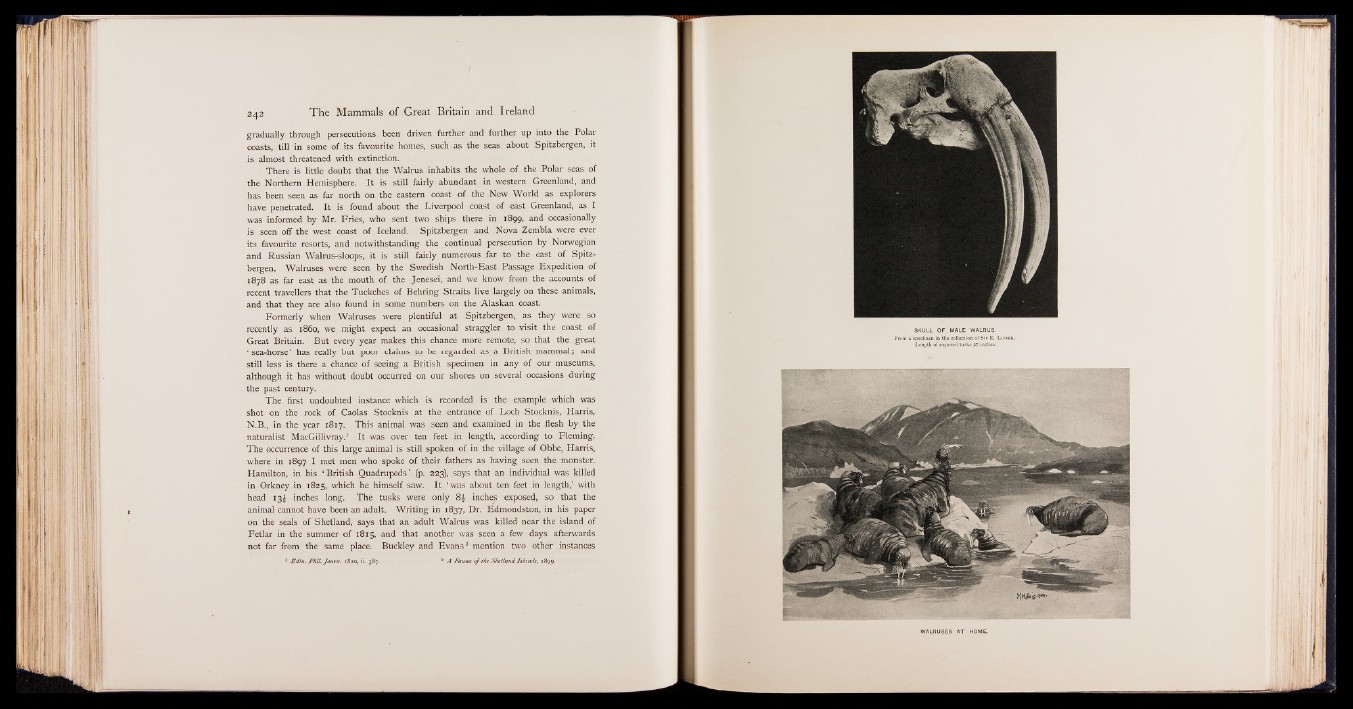
gradually through persecutions been driven further and further up into the Polar
coasts, till in some of its favourite homes, such as the seas about Spitzbergen, it
is almost threatened with extinction.
There is little doubt that the Walrus inhabits the whole of the Polar seas of
the Northern Hemisphere. It is still fairly abundant in western Greenland, and
has been seen as far north on the eastern coast of the New World as explorers
have penetrated. It is found about the Liverpool coast of east Greenland, as I
was informed by Mr. Fries, who sent two ships there in 1899, and occasionally
is seen off the west coast of Iceland. Spitzbergen and Nova Zembla were ever
its favourite resorts, and notwithstanding the continual persecution by Norwegian
and Russian Walrus-sloops, it is still fairly numerous far to the east of Spitzbergen.
Walruses were seen by the Swedish North-East Passage Expedition of
1878 as far east as the mouth of the Jenesei, and we know from the accounts of
recent travellers that the Tuckches of Behring Straits live largely on these animals,
and that they are also found in some numbers on the Alaskan coast.
Formerly when Walruses were plentiful at Spitzbergen, as they were so
recently as i860, we might expect an occasional straggler to visit the coast of
Great Britain. But every year makes this chance more remote, so that the great
• sea-horse ’ has really but poor claims to be regarded as a British mammal; and
still less is there a chance of seeing a British specimen in any of our museums,
although it has without doubt occurred on our shores on several occasions during
the past century.
The first undoubted instance which is recorded is the example which was
shot on the rock of Caolas Stocknis at the entrance of Loch Stocknis, Harris,
N.B., in the year 1817. This animal was seen and examined in the flesh by the
naturalist MacGillivray.1 It was over ten feet in length, according to Fleming.
The occurrence of this large animal is still spoken of in the village of Obbe, Harris,
where in 1897 I met men who spoke of their fathers as having seen the monster.
Hamilton, in his ‘ British Quadrupeds’ (p. 223), says that an individual was killed
in Orkney in 1825, which he himself saw. It ‘ was about ten feet in length,’ with
head 13^ inches long. The tusks were only 8£ inches exposed, so that the
animal cannot have been an adult. Writing in 1837, Dr. Edmondston, in his paper
on the seals of Shetland, says that an adult Walrus was killed near the island of
Fetlar in the summer of 1815, and that another was seen a few days afterwards
not far from the same place. Buckley and Evans2 mention two other instances
Edin. P h il. Joum. 1820, ii. 387. 2 A Fauna o f the Shetland Islands, 1899.
WALRUSES AT HOME.